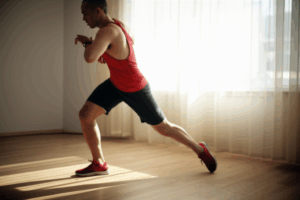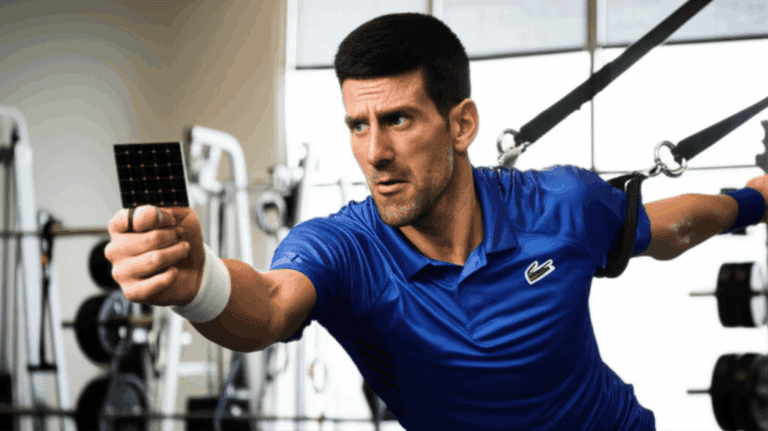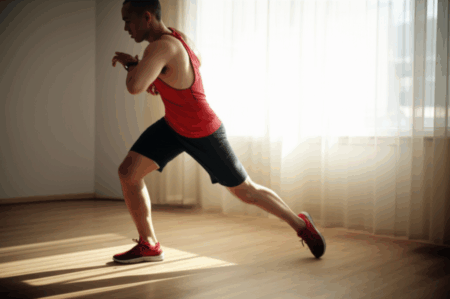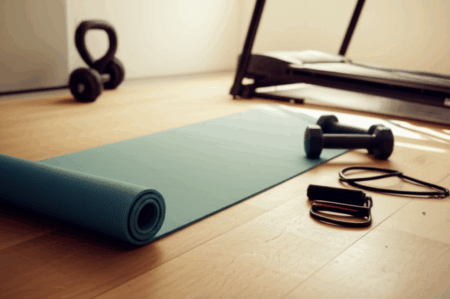Novak Djokovic, even at 38, continues to dominate the world of tennis. His sustained success isn’t just about talent; it’s a testament to his rigorous and holistic approach to fitness, nutrition, and mental fortitude. This guide delves into the key elements of Djokovic’s daily routine, offering insights and practical steps to help you emulate his dedication and achieve your own peak performance.
1. The Mind-Body Connection: Starting with Gratitude and Mental Preparation
Djokovic’s day begins not on the court, but with a focus on mental well-being. He emphasizes the importance of starting the day with gratitude and a positive mindset.
- Gratitude and Intention: Upon waking, Djokovic expresses gratitude for a new day, setting a positive tone.
- Meditation and Mindfulness: Incorporating meditation and mindfulness practices helps manage stress and enhance focus. He often spends 15 minutes in a meditative state before and after physical training.
- Breathing Exercises: Djokovic credits breathing exercises as a cornerstone of his mental toughness. He believes that taking 15 minutes daily for conscious breathing is key to improving mental, physical, and emotional well-being.
How to Implement:
- Start a gratitude journal, writing down a few things you’re thankful for each morning.
- Explore guided meditation apps or techniques for daily mindfulness practice.
- Incorporate deep breathing exercises into your routine to calm your mind and improve focus.
2. Hydration and Nutrition: Fueling the Body Like a Pro
Djokovic’s diet is a critical component of his success. He follows a carefully managed, primarily plant-based diet, emphasizing whole, unprocessed foods.
- Hydration: He starts his day with lukewarm water, lemon, and a pinch of salt to replenish electrolytes and aid detoxification.
- Smoothies and Juices: Djokovic favors fruit-based smoothies or juices packed with vitamins. His go-to blend includes mixed berries, dates, hemp seeds, maca powder, and spirulina.
- Dietary Staples: His diet consists mainly of vegetables, beans, white meat, fish, fruits, nuts, seeds, chickpeas, lentils, and healthy oils. He limits sugar and processed foods to avoid inflammation and energy crashes.
- Breakfast Power Bowl: Djokovic typically eats a “Power Bowl” containing gluten-free muesli or oatmeal, mixed nuts, seeds, and fruits, with coconut oil, rice milk, almond milk, or coconut water.
- Mid-Meal Snacks: He opts for light and nutrient-rich snacks like avocado on gluten-free bread, an apple with nut butter, whole-grain bars with nuts, hummus with apples, or gluten-free crackers with avocado. Dates provide a quick energy boost before matches.
- Dinner: Dinner includes fresh salads with avocado and homemade dressing, soups like carrot and ginger, or organic meat with cooked vegetables.
How to Implement:
- Start your day with warm lemon water to aid digestion.
- Incorporate a daily smoothie packed with fruits, vegetables, and healthy fats.
- Focus on whole, unprocessed foods, limiting sugar, dairy, and gluten.
- Experiment with plant-based meals and snacks to find what works best for your body.
3. Dynamic Warm-Up and Stretching: Preparing the Body for Action
Before hitting the court or engaging in intense training, Djokovic prioritizes a thorough warm-up and stretching routine.
- Light Cardio: He begins with a light run or bike ride to increase blood flow and warm up the muscles.
- Dynamic Stretching: Djokovic incorporates dynamic stretches to simulate everyday movements and prepare his body for the demands of tennis. Examples include:
- Inverted hamstring stretch
- Squat thrusts
- Jumping jacks
- Reverse lunge with backward reach
- Lunge with side bend
- Walking high knees
- Low side-to-side lunge
- Walking high kicks
- Inchworm
How to Implement:
- Start your workouts with 5-10 minutes of light cardio, such as jogging or cycling.
- Incorporate dynamic stretches that mimic the movements of your chosen activity.
- Perform each stretch for 10-20 repetitions, focusing on controlled movements.
4. Tennis Training and Drills: Honing Skills on the Court
Djokovic dedicates significant time to tennis-specific training and drills to refine his technique and strategies.
- On-Court Practice: He spends 4-5 hours a day, six days a week, split between tennis drills, practice matches, and physical fitness workouts.
- Specific Drills: Djokovic focuses on drills that improve his forehand, backhand, serve, and volleys. He emphasizes shot consistency and the ability to hit shots in various situations.
- Footwork Drills: Agility and footwork drills are crucial for court coverage and quick movements.
How to Implement:
- If you’re a tennis player, dedicate time to regular on-court practice and drills.
- Focus on specific areas of your game that need improvement.
- Incorporate footwork drills to enhance your agility and speed on the court.
- For non-tennis players, consider sports-specific drills that mimic the movements of your chosen activity.
5. Strength and Conditioning: Building a Powerful and Resilient Body
Djokovic’s strength and conditioning program is designed to build power, endurance, and stability while maintaining flexibility and agility.
- Calisthenics: He incorporates calisthenics exercises three times a week, including push-ups, pull-ups, squats, and lunges.
- Weight Training: Djokovic uses weight training to build muscular strength, particularly in the lower body. Exercises include squats, lunges, deadlifts, bench presses, and medicine ball throws. He focuses on lighter weights with more repetitions to build endurance rather than bulk.
- Core Strengthening: Planks, Russian twists, and medicine ball exercises are part of his regimen for a strong core, enhancing balance and stability.
- Rotational Exercises: He integrates rotational exercises to improve timing and stroke speed, fortifying muscles around the spine, hips, and shoulders to prevent injuries.
- Aerobic Exercise: Djokovic uses a stationary bike as his go-to tool since this simple machine is a great way to boost your cardiovascular strength. If you don’t have one at home and you don’t want to go to the gym, running, swimming, walking, hiking, cross country skiing, and kickboxing are also some great aerobic exercises.
- Resistance Training: Djokovic employs resistance training exercises, such as squats, lunges, and deadlifts, to build his muscular strength, particularly in the lower body, which is crucial for explosive movements on the tennis court.
How to Implement:
- Incorporate calisthenics exercises into your routine 2-3 times a week.
- Focus on compound exercises that work multiple muscle groups.
- Use lighter weights with more repetitions to build endurance.
- Include core strengthening exercises to improve balance and stability.
- Integrate rotational exercises to enhance power and prevent injuries.
6. Flexibility and Mobility: Maintaining Agility and Preventing Injuries
Djokovic’s flexibility and mobility are essential for his agility on the court and for preventing injuries.
- Yoga and Pilates: He practices yoga and Pilates to improve flexibility, balance, and core strength. Poses like Downward Dog, Warrior, and Pigeon Pose help in stretching and strengthening various muscles.
- Foam Rolling: Djokovic uses foam rolling to loosen up connective tissue around the muscles and reduce stiffness. He suggests using a foam roller on the calves, glutes, lower back, upper back, hamstring, quads, hips, and shoulder blades.
- Stretching: Even if he is competing in a low priority match or participating in a charity event, he won’t avoid mobilizing his entire body.
How to Implement:
- Incorporate yoga or Pilates into your routine 1-2 times a week.
- Use a foam roller to massage tight muscles and improve flexibility.
- Perform static stretches after workouts, holding each stretch for 20-30 seconds.
7. Recovery and Rest: Prioritizing Muscle Repair and Rejuvenation
Recovery is a crucial part of Djokovic’s fitness regimen. He takes it as seriously as his training.
- Sleep: Djokovic aims for at least 8-9 hours of sleep per night to allow his body to recover fully.
- Massage Therapy: He utilizes massage therapy to reduce muscle soreness and inflammation.
- Cryotherapy: Djokovic uses cryotherapy, exposing his body to frigid temperatures to accelerate muscle recovery and reduce inflammation.
- Active Recovery: He engages in low-intensity activities such as swimming or light cycling on his rest days to promote blood circulation and muscle repair.
- Epsom Salt Baths: He uses Epsom salt baths to reduce muscle soreness and aid recovery.
- Sauna and Ice Baths: After staying active all day, Djokovic ends with recovery. He uses ice baths and sauna sessions to relax his muscles and prepare his body for the next day. These help reduce soreness and keep his energy levels high.
- Naps: He also incorporates naps into his routine, particularly on match days, to ensure he is fully rested and energized.
How to Implement:
- Prioritize sleep, aiming for 7-9 hours per night.
- Schedule regular massage therapy sessions to reduce muscle tension.
- Explore cryotherapy options or ice baths for reducing inflammation.
- Engage in active recovery activities on your rest days.
- Add 2 cups of Epsom salt to a warm bath. Soak for 10–20 minutes after matches or training. Repeat 2–3 times a week for optimal results.
8. Mental Toughness: Cultivating a Champion’s Mindset
Djokovic emphasizes that mental strength is not a gift but a skill developed through training.
- Visualization: He mentally rehearses critical points and matches.
- Mindfulness and Meditation: Djokovic practices mindfulness and meditation as a part of his daily routine to manage stress and stay focused.
- Positive Self-Talk: He focuses on positive self-talk and emotional regulation.
- Breathing Exercises: Djokovic has stated that breathing exercises are one of the main reasons for his mental toughness.
How to Implement:
- Practice visualization techniques to mentally prepare for challenges.
- Incorporate mindfulness and meditation into your daily routine.
- Focus on positive self-talk to build confidence and resilience.
- Use breathing exercises to calm your mind and manage stress.
9. Cross-Training and Active Lifestyle: Staying Active Beyond the Court
Djokovic incorporates various activities into his routine to maintain his athleticism and prevent injuries.
- Cross-Training: He enjoys activities like swimming in the sea, biking, hiking, running, and playing sports like football, basketball, padel, and ping pong.
- Altitude Training: His workout often includes training at high altitudes, a practice that builds endurance and stamina. This could involve hiking or training in mountainous regions.
- Active Rest: Even on Sundays, his day off includes “active rest,” which involves stretching and yoga.
How to Implement:
- Incorporate cross-training activities into your routine to challenge different muscle groups and prevent boredom.
- Find activities that you enjoy and that keep you motivated to stay active.
- Prioritize active rest on your off days to promote recovery and prevent stiffness.
10. Injury Prevention: Protecting the Body for Long-Term Performance
Djokovic’s routine includes proactive measures to prevent injuries and maintain his physical well-being.
- Proper Technique: He works with coaches and trainers to ensure proper technique and form, reducing the risk of injury.
- Flexibility and Mobility: Regular stretching and mobility exercises help maintain joint health and prevent muscle strains.
- Listen to Your Body: Djokovic emphasizes the importance of listening to your body and resting when needed to prevent overtraining and injuries.
How to Implement:
- Work with qualified coaches and trainers to improve your technique and form.
- Incorporate regular stretching and mobility exercises into your routine.
- Pay attention to your body and rest when needed to prevent overtraining and injuries.
The Team Behind the Champion
Djokovic relies on a team of experts to support his fitness and well-being. Key members of his team have included:
- Fitness Coaches: Marco Panichi, Gebhard Phil-Gritsch.
- Physiotherapists: Ulises Badio.
- Coaches: Dusan Vemic, Boris Bosnjakovic.
By following these steps and incorporating them into your daily life, you can emulate Novak Djokovic’s dedication to fitness and well-being. While you may not become a Grand Slam champion, you can achieve your own peak performance and enjoy a healthier, more fulfilling life. Remember to consult with healthcare professionals or certified trainers before making significant changes to your fitness routine.







